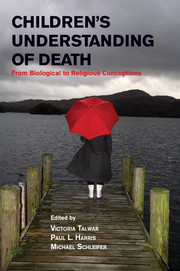Book contents
- Frontmatter
- Contents
- List of Figures and Table
- List of Contributors
- Preface and Acknowledgments
- 1 Death, Ancestors, and the Living Dead: Learning without Teaching in Madagascar
- 2 Death in Spain, Madagascar, and Beyond
- 3 Ambivalent Teaching and Painful Learning: Mastering the Facts of Life (?)
- 4 Death in the Lives of Children
- 5 Talking to Children about Death in Educational Settings
- 6 Responsible Believing
- 7 Thoughts and Feelings: Children and William James Have It Right!
- 8 How the Law Constructs Its Understanding of Death
- Index
- References
3 - Ambivalent Teaching and Painful Learning: Mastering the Facts of Life (?)
Published online by Cambridge University Press: 03 May 2011
- Frontmatter
- Contents
- List of Figures and Table
- List of Contributors
- Preface and Acknowledgments
- 1 Death, Ancestors, and the Living Dead: Learning without Teaching in Madagascar
- 2 Death in Spain, Madagascar, and Beyond
- 3 Ambivalent Teaching and Painful Learning: Mastering the Facts of Life (?)
- 4 Death in the Lives of Children
- 5 Talking to Children about Death in Educational Settings
- 6 Responsible Believing
- 7 Thoughts and Feelings: Children and William James Have It Right!
- 8 How the Law Constructs Its Understanding of Death
- Index
- References
Summary
These reflections on death awareness in children and adults are informed by observations about the human capacity to account for all events through anthropocentrism, that is, creating pleasant fantasies sometimes known as religion. Death has always been the most important challenge to our natural anthropocentrism. Still, our intuitive way of placing each one of us, and humanity as a whole, at the center of the universe, although constantly challenged, is never defeated. More recently, humanity has managed to develop some nonanthropocentric ideas about nature and our place in it, including death, but these new ideas may coexist with more traditional notions.
My reflections will be presented in a series of binary oppositions: traditional death awareness versus modernity; the wish to protect versus the duty to educate; mature understanding versus Innocence; basic research versus the grief context; biological death versus the bypassing of the biological; and universality versus death of self.
TRADITIONAL DEATH AWARENESS VERSUS MODERNITY
Modern culture has been described and criticized as a web of ideas that avoids at any cost the recognition of death as part of life. There have been charges that modernity means the belief in the abolition of death. One major critic of modernity stated: “Our modern model of death was born and developed in places that gave birth to two beliefs: first, the belief in a nature that seemed to eliminate death; next, the belief in a technology that would replace nature and eliminate death” (Ariès, 1981, p. 595).
- Type
- Chapter
- Information
- Children's Understanding of DeathFrom Biological to Religious Conceptions, pp. 41 - 60Publisher: Cambridge University PressPrint publication year: 2011
References
- 4
- Cited by



